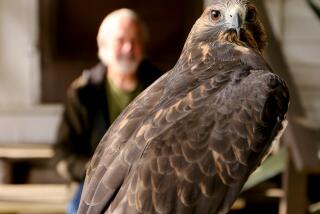Wounded Condor to Undergo Surgery
- Share via
The first California condor shot since the rare birds were returned to the wild will undergo reconstructive surgery today to repair its shattered leg.
As U.S. Fish & Wildlife Service investigators in Ventura continue a criminal probe into who shot the condor in Santa Barbara County, veterinarians will perform their second operation on the 13-month-old male.
Scientists believe the bullet came from a small-caliber rifle that blew apart the lower portion of the tarsometatarsal bone in the right leg. The bone shattered to such an extent that the condor must now spend the rest of its expected 50-year life span in captivity.
“This bird won the lottery to be selected for and released in the wild, and he had been doing very well--one of our star pupils,” said Mike Wallace, a biologist who heads the condor recovery program at the Los Angeles Zoo. “Then this irresponsible individual wipes out this bird’s chance to be free.”
Biologists--who track the condors visually and with radio telemetry transmitters attached to the condor’s wings and tails--spotted the wounded bird the afternoon of May 20, said Robert Mesta, a U.S. Fish & Wildlife Service biologist in Ventura.
Mesta said observers noticed the bird limping at the Lion Canyon feed station, 50 miles north of Ojai. Biologists monitored the bird for several days before capturing it June 2 with a net gun and transporting it to the Los Angeles Zoo.
“We were thinking it was a sprain or that it collided with something,” Wallace said of the initial reports on the wounded bird. An inspection after capture, however, showed the injury to be far worse. A subsequent X-ray uncovered tell-tale white flecks indicating that shards of metal--most likely from a bullet--had lodged inside the broken bones.
“It was only a matter of time before we had a bird shot,” Wallace said. “We’ve been lucky so far.”
Today’s operation by veterinarians is the second since the bird was captured. In the first operation, veterinarians spent two hours reconnecting the bird’s bone fragments with nearly a dozen metal pins and a special leg cast, Wallace said. Today they will continue the reconstructive surgery, which could still require more operations.
Fish & Wildlife Service crime lab investigators in Ashland, Ore., are now conducting a ballistics investigation on other bone fragments from the condor. So far, there are no suspects.
Under the U.S. Endangered Species Act, anyone convicted of shooting a California condor faces up to a year in federal prison and/or $100,000 in fines, said Diane Petrula, a Fish & Wildlife Service special agent.
In 1993, a Long Beach man was given two years’ probation and a $1,500 fine for shooting at a condor in Ventura County.
“They’re an endangered species, and we’re trying to keep them from going extinct,” Petrula said. “There’s a lot of effort, time and money by many people to keep those birds alive. It’s too bad that somebody took it upon themselves to shoot it.”
The California condor was among the first species placed on the federal endangered species list, added in March 1967. It is also protected under the federal Migratory Bird Treaty Act of 1918.
Wallace said a public education campaign that includes large posters placed in the condor release sites warning against shooting the birds have helped keep the vultures safe. Licensed hunters, he said, are among the birds’ greatest unofficial protectors.
“We have immense support from the legal hunting community,” Wallace said. “They call us up and let us know when they see the birds. The problem is anyone who just sees shooting anything out there as a fun way to spend time.”
The wounded condor is one of 38 condors bred in captivity and released into the wild since the species was brought back from near extinction in the late 1980s.
In 1987, scientists captured the last of the 27 wild California condors and entered them into a captive breeding program credited with saving the species.
Some of the first chicks released in Ventura County in 1992 died in collisions with taut power lines as they prepared to perch on the power poles. Another died of kidney failure after drinking anti-freeze. Since then, biologists have begun releasing the birds farther from civilization in the wilds of Santa Barbara County. And in a sanctuary near Fillmore, they also train the young condors to avoid human hazards.
The bird, a scavenger that can weigh up to 24 pounds and have a wingspan of 9 1/2 feet, flies free in two California locations: the Ventana Wilderness Sanctuary near Big Sur in Monterey County, and in Santa Barbara County between Lion Canyon and Castle Crag.
Two years ago the birds were reintroduced to the Grand Canyon in Arizona, marking the first time the California condor has flown there in 75 years.
There are now 153 condors in existence, with the 154th expected to peck free from its shell at the Los Angeles Zoo on Monday, Wallace said.
More to Read
Sign up for Essential California
The most important California stories and recommendations in your inbox every morning.
You may occasionally receive promotional content from the Los Angeles Times.













